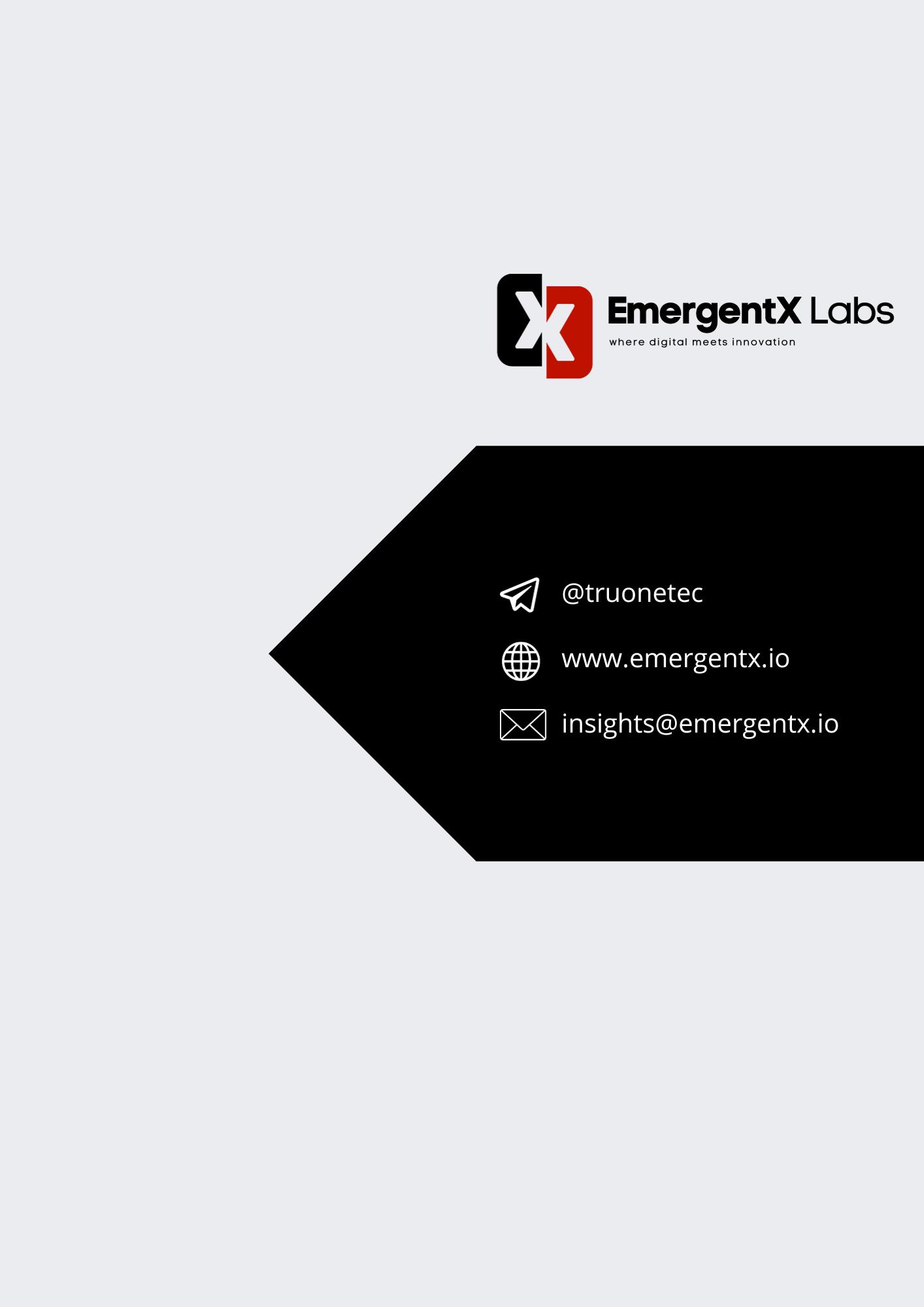






EmergentX Labs is proud to present our 4Q 2023 outlook report as the web3 ecosystem matures and digital assets become increasingly mainstream. This carefully curated collection of six project analyses offers insights into the latest trends in blockchain projects across various topics, from DeFi, and Layer 1 to meta-verse and GameFi.
We believe this outlook report reflects a deep understanding of blockchain technology and its potential to revolutionize how we exchange value. Our insights team has drawn on our experience in Web3 to provide an informed outlook on current conditions and future opportunities. This report is meant to be a resource for those looking to understand more about this dynamic industry and how Web3 is changing how we live, interact, and experience.
Our exceptional capabilities are on full display in this report, with each analysis drawing on our expansive knowledge, rigorous research methodologies, and discerning perspectives. We delve into novel concepts, forecast trends, and provide a comprehensive understanding of each blockchain project under review. This report is more than just an outlook; it demonstrates our capabilities and steadfast dedication to advancing the Web3 ecosystem. We trust that our readers will find it both enlightening and beneficial, grounding their web3 and digital asset decisions in expert insights and robust analysis.
EmergentX Labs has established itself as an authoritative voice in the digital assets and Web3 community. Our dedication to progressive thinking and continual research has positioned us at the forefront of the industry, influencing and navigating the trajectory of this evolving space. This 4Q 2023 outlook report is a testament to our deep-rooted expertise and our unwavering commitment to delivering informed, insightful, and actionable intelligence to our readers.
The selection of projects for analysis in our 4Q 2023 outlook report was a meticulous process underpinned by a comprehensive set of criteria. Our primary objective was to ensure a broad representation of the Web3 landscape, offering insights into various projects, each with unique propositions and innovative solutions.
Our three major selection criteria:
1. Firstly, we considered each project's technological innovation, assessing the unique advantages, potential scalability, and robustness of the underlying blockchain technology.
2. Secondly, we evaluated the project's potential for real-world impact, considering factors such as the size of the problem they aim to resolve, market potential, and practical feasibility of their proposed solutions.
3. Last but not least, we looked at the team behind each project their expertise, vision, and ability to execute and adapt in this rapidly evolving industry. This rigorous process ensured that we only selected projects that exemplify the transformative potential of Web3 and offer exciting opportunities for the future.
The web3 projects that were considered in our 4Q 2023 outlook report included:
As a high-performance blockchain platform, Solana has emerged as a powerful contender in the Web3 arena. Its impressive transaction speed and scalability make it an ideal platform for building decentralized applications, contributing to the growth and innovation within the crypto ecosystem.
An optimistic rollup project that aims to scale Ethereum's capabilities, Arbitrum has caught the attention of many within the crypto community. Its innovative approach to facilitating faster transactions and lower fees while preserving the decentralized ethos of blockchain holds immense potential for the future of Web3.
Blur is a progressive, Ethereum-based NFT marketplace and aggregator known for its innovative analytics, portfolio management features, and zero platform fees, targeting NFT traders. This platform is carving a distinctive niche in the Web3 universe by focusing on efficiency, liquidity, and speed.
Fetch.ai is pioneering the convergence of artificial intelligence with blockchain, creating a digital world where autonomous software agents perform valuable economic work. This project represents a fascinating intersection of advanced technology and Web3, promising exciting developments for the future.
A virtual world where players can build, own, and monetize their gaming experiences, Sandbox exemplifies the transformative potential of blockchain in the gaming industry. As a prime example of the metaverse and "play-to-earn" theme, Sandbox offers intriguing insights into the future of digital economies.
As the native cryptocurrency of the OKEx trading platform, OKB has carved out a significant niche in the crypto ecosystem. With OKEx's focus on fostering a global blockchain community and facilitating digital asset trading, OKB holds a unique position within the evolving panorama of web3 projects.
The analytical approach adopted by EmergentX Labs, in evaluating these projects, uniquely considers each project's sustainability and environmental, social, and governance (ESG) factors. This dimension of analysis has grown increasingly vital in the aftermath of incidents such as FTX, which have significantly shaken confidence in the crypto market. These events have underscored the importance of sustainability considerations in the Web3 realm, not only as ethical imperatives but as critical factors in maintaining market stability and confidence. As we journey into the fourth quarter of 2023, it becomes clear that these sustainability and ESG considerations will play a defining role in how the web3 and crypto landscapes evolve.
In conclusion, this 4Q 2023 outlook report is a critical resource for those looking to navigate the complex landscape of Web3 and digital assets. The analysis contained herein will not only provide a comprehensive understanding of how these projects are shaping the future of the Web3 ecosystem, but it will also offer a forward-looking perspective on the shifting dynamics of the crypto market. We believe this report will significantly impact the broader professional community, enabling investors, developers, entrepreneurs, and academics to make informed decisions, foster innovation, and drive the adoption of blockchain technology.
As we witness rapid advancements in the Web3 landscape, we recognize the importance of staying abreast with the latest developments. Our commitment at EmergentX Labs is to continue providing valuable insights and contributing to this ever-evolving dialogue.
We wish all our readers success in their Web3 journey and hope this report provides a valuable compass in the dynamic and exciting world of digital assets.
EmergentX Labs Insights Team August 2023
As a high-performance blockchain platform, Solana has emerged as a powerful contender in the Web3 arena. Its impressive transaction speed and scalability make it an ideal platform for building decentralized applications, contributing to the growth and innovation within the crypto ecosystem.
Solana is a Layer1 blockchain and provides a platform where developers can create Dapps, DeFi applications, Web3 gaming, NFTs, NFT marketplaces, and ICOs for crowdfunding. Solana uses the Rust programming language for its Web3 infrastructure. Solana blockchain is a scalable, efficient, and fast blockchain where users experience low fees and fast transaction speeds for utilizing their platform.
SOL is a native token of the Solana blockchain, which is used for staking, paying transaction fees on the Solana network, for governance to vote on proposals, lending and borrowing, purchasing NFTs on the Solana blockchain, and paying for services on Dapps that run on the Solana blockchain.
Solana blockchain offers many features to its users, like a high TPS of around 50,000 transactions per second. Users do not have to wait minutes for their transactions to be confirmed. Solana offers low transaction fees for using its platform to do transactions, build Dapps, and make Web3 projects. Solana blockchain is EVM compatible, where developers can deploy and migrate EVM-supported Dapps. This project provides cross-chain functionalities where users can send data from one blockchain to another.
Solana blockchain has a large community base of people using its platform to build applications, small and big investors who are active on social media platforms. It has around 11.5 million active accounts and 1800 validator nodes. A total of 183,648,663,205 transactions have been completed. Top 10 ranking in the entire crypto market, the strong team makes this project one of the leading and significant blockchain ecosystem projects
Solana blockchain uses unique approaches to solve the blockchain trilemma like scalability, security, and decentralization. Solana blockchain uses a Sea-level consensus mechanism, a combination of Tower BFT and Proof of History consensus mechanism. Tower BFT is a consensus mechanism designed to ensure that all nodes in a network agree on the ledger's state, even if some nodes are malicious or unavailable. Proof of History is a consensus mechanism that creates a tamper-proof record of events that can be used to order transactions. This helps to prevent double-spending and other attacks. This consensus mechanism is vital for Solana to reach high performance and security.
The operating model of Solana is designed to achieve high throughput, low latency, security, and scalability by using various protocols such as Gulfstream, Turbine, Transaction Processing Unit (TPU), Transaction clustering, Transaction batching, Transaction fee prioritization, etc. Gulfstream is a protocol that allows Solana to process transactions in parallel. It does this by dividing the network into shards, each of which can process transactions independently. Turbine is a protocol that is used to broadcast blocks across the network. It is designed to be very efficient, allowing Solana to achieve high throughput.

Transaction Processing Unit (TPU) is a hardware accelerator that processes transactions on Solana. It can process transactions much faster than a traditional CPU or GPU. Transaction clustering is a transaction related to each other, grouped and processed as a single transaction. It can significantly reduce the number of transactions that need to be processed. Transaction batching is a transaction that is batched together and processed as a single unit. This helps to improve performance.
Transaction fee prioritization is when transactions with higher fees are processed ahead of transactions with lower fees. This helps to process the most critical transaction first.
A user submits a transaction to the network after that transaction is routed to the leader validator, the node responsible for processing transactions for that shard. The leader validator uses POH to order the transaction and add it to a block. The block is broadcast to the rest of the network. After that, the validator on each shard verifies the block and adds it to their ledger.
Solana Mobile stack – The Solana team will launch a mobile stack platform that will make it easier for developers to build Solana-based applications for mobile devices.
Solana Pay - This payment protocol is designed to make it easier for merchants to accept Solana payments.
Solana DeFi – The team plans to expand the DeFi ecosystem on Solana, including developing new DeFi protocols and integrating Solana with other DeFi projects.
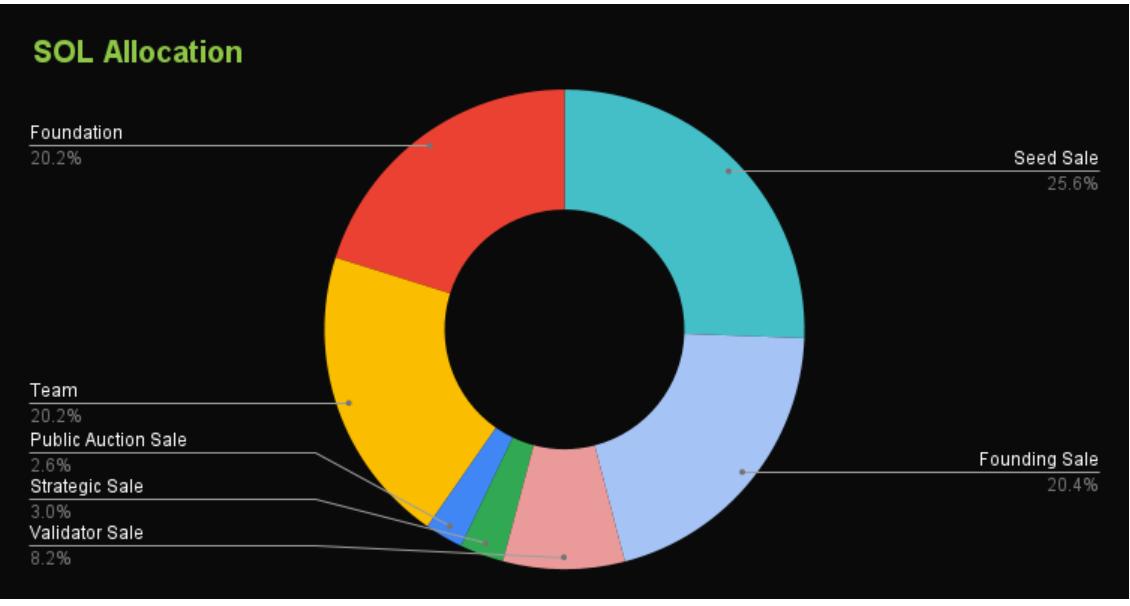
Solana NFTs – This includes the development of new NFT marketplaces and the integration of Solana with other NFT platforms
Solana Gaming – This includes developing new Solana-based games and the integration of Solana with other gaming platforms.
Solana Enterprise – This includes the development of a Solana-based supply chain management solution and a Solana-based gaming solution.
Solana has emerged as one of the most promising blockchain platforms, focusing on high throughput and low latency. However, the question of sustainability is pivotal for long-term success. Unlike traditional proof-of-work networks, Solana uses a proof-of-history mechanism alongside proof-ofstake, reducing its energy footprint considerably. This makes Solana an eco-friendly alternative in the blockchain space.
An optimistic rollup project that aims to scale Ethereum's capabilities, Arbitrum has caught the attention of many within the crypto community. Its innovative approach to facilitating faster transactions and lower fees while preserving the decentralized ethos of blockchain holds immense potential for the future of Web3.
Arbitrum is a layer-two scaling solution for Ethereum designed to improve the scalability and efficiency of the Ethereum network. Arbitrum uses Optimistic Rollup, which allows for off-chain transaction processing while inheriting the Ethereum network's security. Arbitrum is EVM compatible, meaning that smart contracts and decentralized applications (Dapps) built on Ethereum can be easily deployed on the Arbitrum network with minimal modifications.
ARB is a native token of the Arbitrum network which is used for staking, to pay transaction fees on the Arbitrum network, for lending and borrowing purposes on various DeFI platforms, used to buy and sell NFTs on Arbitrum-based NFT marketplaces, to pay for services on Dapps that run on the Arbitrum network which includes gaming, DeFi, and other applications.
Arbitrum is a fast and scalable blockchain. It can process thousands of transactions per second at an affordable cost. Its security features are robust and use various security measures to protect users' funds. Arbitrum is an EVM-compatible blockchain where developers can deploy and migrate EVMbased applications to another blockchain. This is one of the highly TVL-based projects. The project has a strong community, has gained much traction in recent years, and has become one of the leading Layer 2 scaling projects for the Ethereum ecosystem.
Developer-Friendly: Arbitrum offers a developer-friendly environment for building decentralized applications. It supports Solidity, the programming language used for Ethereum smart contracts, and provides tooling and documentation to help developers easily migrate their applications to Arbitrum.
Gas Fees and Incentives: While off-chain processing significantly reduces transaction fees on Arbitrum, there are still costs associated with interacting with the Ethereum mainnet for settlement and security. Users pay gas fees on the Ethereum network when they submit transactions or interact with the Arbitrum system. Validators in the Arbitrum network are also incentivized through various mechanisms, such as transaction fees and staking rewards, to ensure the proper functioning and security of the network.
Arbitrum is a layer-2 scaling solution for Ethereum. It uses optimistic rollup technology by batching transactions off-chain and then submitting them to the Ethereum mainchain for verification. Arbitrum has two operating models: the Sequencer-based model and the Decentralized model.
In the sequencer-based model, a single sequencer is responsible for ordering and executing transactions on the Arbitrum rollup. The decentralized model allows multiple sequencers to compete to order and complete transactions on the Arbitrum rollup. The sequencer-based model is the most popular model for Arbitrum because it provides low transaction fees and high throughput. Still, it is centralized, which could pose a security risk.
Let us see how Arbitrum Layer 2 works, and then we will discuss their operating model diagram to see how it internally works:
Arbitrum uses an optimistic rollup technique to process transactions off-chain. Whenever a user initiates a transaction on the Arbitrum Network, a network of validators first executes it off-chain. This off-chain processing makes this platform faster and cheaper. After off-chain processing, Arbitrum generates fraud-proof, also called summary proof (succinct proof). It contains the information necessary to prove the validity of the transaction. This type of parameter is then submitted to the Ethereum mainnet.
After posting proof of fraud on the Ethereum mainnet, which guarantees the validity of off-chain transactions, fraud-proof can be used to challenge and reverse any invalid transactions if any disputes or fraudulent activities are detected during off-chain processing. The Ethereum mainnet ensures the security and integrity of the system. The off-chain transaction is finalized once all the formalities are completed. This finalization process provides the necessary security guarantees and ensures that the state of the Arbitrum network is aligned with the state of the Ethereum mainnet. So, let’s discuss its operating model architecture:
Arbitrum Layer 2 operates on the VM state machine, an essential part of the Arbitrum operating model. This ensures that VMs are executed securely and orderly, which is critical to the safety of users' funds and the integrity of the Arbitrum network. It has five stages: Created, Queued, Running, Halted, and Closed. The created state is the initial state of a VM. It is created by a user who wants to deploy a smart contract on Arbitrum. The user submits a transaction to the Arbitrum sequencer, which makes the VM and stores it on-chain.
The Queued state is that the VM is waiting to be executed. The Arbitrum sequencer queues the VM for execution based on a few factors, such as the priority of the transaction and the amount of gas that the user has paid. The Running state means that the VM is currently being executed. The Arbitrum sequencer executes the VM by sending it instructions one at a time. The sequencer also verifies that the VM is performing correctly and does not violate any of the rules of the Arbitrum protocol.
The Halted state is that the VM has finished executing. It is halted by the Arbitrum sequencer when the VM reaches the end of its code or encounters an error. The closed state is that the VM is no longer needed. It is closed by the Arbitrum sequencer when the user who created the VM deletes it. There are some rules according to these rules VM can move from one state to another. These rules are designed to ensure that the VM is executed securely and orderly, such as a VM can only be created by a user with sufficient funds to pay for its execution. The Arbitrum sequencer can only
execute a VM if it has been queued. Arbitrum sequencer can only halt a VM if it has reached the end of its code or encountered an error. Users who created a VM can only close it if it is in the halted state.
Q1 2023 – Launch of Arbitrum One
Q2 2023 – Support for more complex applications on Arbitrum One

Q3 2023 – Improved Security for Arbitrum One
Q4 2023 – Launch of Arbitrum AnyTrust
Arbitrum, an Ethereum Layer 2 scaling solution, is gaining attention for its ability to reduce transaction costs and increase speed significantly. From a sustainability standpoint, Arbitrum offers promising advantages. By handling most transactions off-chain and settling the net result on the Ethereum mainnet, it mitigates congestion and reduces the energy-intensive computations required for each transaction. This contributes to a smaller carbon footprint, aligning with growing concerns over the environmental impact of blockchain technologies.
Blur is a progressive, Ethereum-based NFT marketplace and aggregator known for its innovative analytics, portfolio management features, and zero platform fees, targeting NFT traders. This platform is carving a distinctive niche in the Web3 universe by focusing on efficiency, liquidity, and speed.
Blur is an NFT Marketplace that is built on the Ethereum blockchain. This project takes zero fees for buying and selling NFTs on their marketplace. Blur NFT has its Blend Lending platform, a P2P lending protocol that allows users to borrow ETH with NFTs as collateral.
BLUR is a native token of this project, which is an Ethereum-based token. Blur token has various utility in the Blur ecosystem. Blur token is usable on the Blur NFT marketplace and the Blend lending platform, where users can use blur token to pay fees on the Blur NFT marketplace, participate in governance, for staking purposes to get passive rewards, and use as collateral for loans.
This NFT marketplace project brought unique and valuable features such as zero trading fees, NFT sweeping features, NFT analytics, Competition and rewards, Royalties program, Pricing, Decentralized governance, etc.
Blur NFT charges zero trading fees for both buyers and sellers. Blur NFT offers an NFT sweeping feature that automatically allows users to buy and sell NFTs based on specific criteria. It is a great way to automate NFTs and saves time. Blur NFT offers an NFT analytics dashboard that provides users with data on NFT prices, trading volume, and other metrics. This dashboard helps the User to check NFT's performance and make informed decisions.
Blur NFT hosts regular competitions and rewards programs that allow users to win prizes. Blur NFTs marketplace offers a royalties program where artists could earn a percentage of the sale price of their NFTs every time they resold. The Blur royalty rate is 5%. Creators can set their royalty rates up to 10%. Blur also offers a royalty-free program for creators who own high-quality collections with a strong community. A pricing program also uses a combination of factors, such as the rarity of the NFT and the demand of the collection, to generate a suggested price for each NFT. Creators can choose to use the suggested price or set their price.
Blur token is an ERC-20 token built on the Ethereum blockchain. Blur token has various utility in the Blur ecosystem. Blur token is usable on the Blur NFT marketplace and the Blend lending platform, where users can use blur token to pay fees on the Blur NFT marketplace, participate in governance, for staking purposes to get passive rewards, and use as collateral for loans.
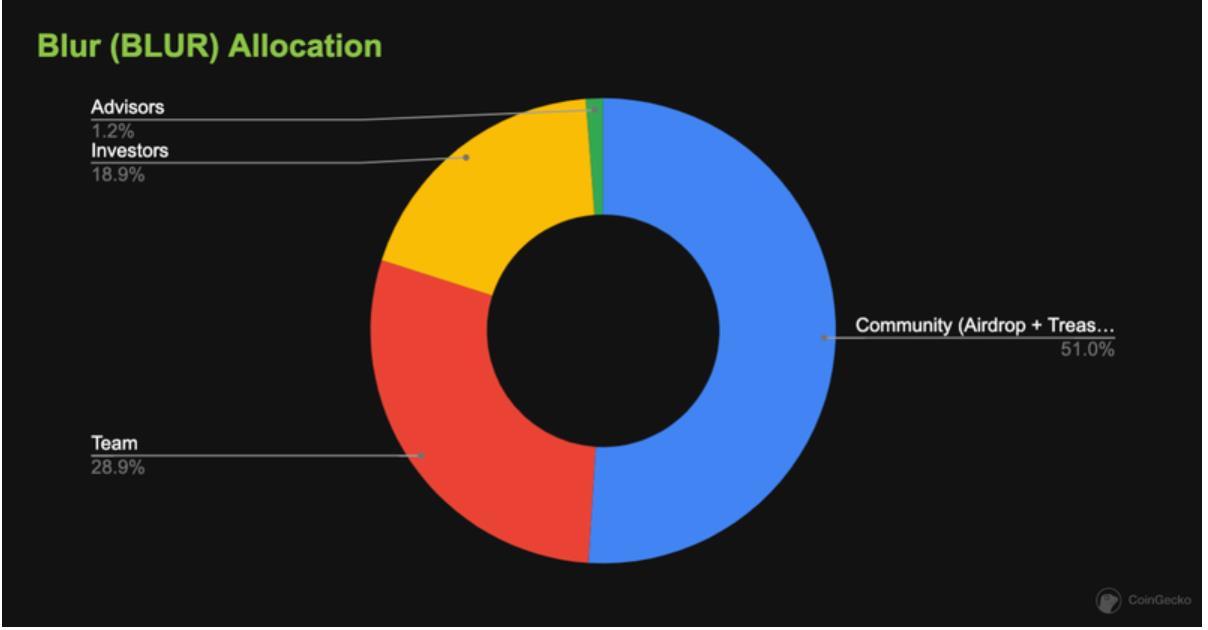
If we talk about the ecosystem of Blur, they have two products: Blur NFT Marketplace and Blend Lending Protocol. Blur NFT Marketplace is an Ethereum-based NFT marketplace where users can buy and sell NFTs using Eth and Blur tokens. The Blend Lending platform is a P2P lending protocol that allows users to borrow eth with NFTs as collateral.
Blur NFT provides discounted fees to use their native token, Blur to list NFTs for sale, bid on NFTs, and transfer NFTs on the Blur NFT marketplace. Blur token holders can stake their tokens to earn passive rewards. Blur tokens can be used as collateral for loans.
Expanding the NFT marketplace – Blur plans to offer more features to its NFT marketplace, such as the ability to create and sell NFT collections and to trade NFTs between different blockchains.
Launching a new token – The new token will be used to pay for fees, vote on governance proposals, and access exclusive features.
Expanding into new markets – Blur plans to expand into new markets such as Asia, Latin America, and other countries.
Partnering with other projects – Blur plans to partner with other projects in the NFT space, such as marketplaces and wallets. This will help to grow the Blur ecosystem and make it easier for users to buy, sell, and trade NFT.
Fetch.ai is pioneering the convergence of artificial intelligence with blockchain, creating a digital world where autonomous software agents perform valuable economic work. This project represents a fascinating intersection of advanced technology and Web3, promising exciting developments for the future.
Fetch.ai is a decentralized machine learning network of agents that can perform various tasks, from data analysis, exchanging data, automated trading, and prediction to complex financial modeling and many more things. Agents are just software programs that are designed to perform specific tasks. These are autonomous and self-organizing, meaning they can make their own decisions and take actions without human intervention.
FET is the native token of the Fetch.ai network, which is used to pay for transaction fees and services, including deploying agents, accessing data, and participating in governance for staking and trading in the secondary market.
Fetch.ai provides us with real-world application usage for Supply chain management, Smart contracts, Decentralized finance, Data trading, Autonomous vehicles, The Internet of Things, etc. Using the technology of the Fetch.ai network, we can track the movement of goods and materials through the supply chain application. We can use this technology to optimize energy consumption and production. Using this technology, users can coordinate the activities of smart homes and businesses, ensuring that they use energy efficiently. Using this network, we can automate financial trading, which helps us reduce costs and improve efficiency.
We can use this network for transportation to coordinate the activities of self-driving cars and trucks, ensuring that they are moving efficiently. Fetch.ai could be used to manage traffic lights, optimize energy use, collect data on air quality, and many more. Fetch Network is in its early stages, and its ecosystem is growing. We will see more real-world applications that will run on the Fetch.ai network.
Fetch.ai provides an economic framework that enables agents to engage in various economic activities, such as trading goods and services, sharing data, and participating in marketplaces, while
leveraging decentralized technology's advantages. The platform incorporates machine learning techniques, allowing agents to learn and improve their decision-making processes.
Fetch.ai is EVM-supported, while users can migrate and deploy Ethereum-based Dapps on the Fetch network. It provides a decentralized machine learning network, support for digital twin applications, and supports a high-level programming language called Cartesia.
The Fetch.ai blockchain is built on the Cosmos SDK. It uses Cosmos SDK modular frameworks and their unique features, such as IBC, security, and scalability features, to interact with other blockchains because it is essential for agents to communicate with each other and access data from other blockchains.
The operating model of Fetch.ai is based on a decentralized network of agents that can perform a wide range of tasks, from data analysis and prediction to complex financial modeling. Agents are software programs that are designed to perform specific tasks. These are autonomous and selforganizing, meaning they can make their own decisions and take actions without human intervention They interact with each other directly via the blockchain network. Any agreements between agents are then recorded on the Fetch.ai blockchain using FET.
Fetch.ai combines network, agents, blockchain, AI terminologies, and the FET token. It also includes the developers, businesses, and users who participate in the network. If we discuss this project's terminologies broadly, we have Agents – software programs designed to perform specific tasks. Fetch.ai has its blockchain to record the transactions and agreements between Agents. This blockchain uses the Cosmos SDK framework to get security and intercommunication functionalities that Agents can communicate with each other and access data from other blockchains.
Fetch.ai provides a permissionless, decentralized machine-learning network that combines multi-party cryptography and game theory to provide secure, censorship-resistant consensus and rapid chainsyncing to support digital twin applications. Multi-party cryptography allows multiple parties to share data without revealing it to each other. Game theory is used to design incentive mechanisms that discourage bad behavior on the network. Digital twins are virtual representations of physical objects or systems. The Fetch network uses digital twins to allow agents to interact with the physical world.
Machine learning is an integral part of AI by leveraging this technology Fetch network to allow agents to learn and make informed decisions. Fetch uses WASM-based smart contract language to create smart contracts on the Fetch network. Fetch network also supports a Cartesia programming language that can be used to develop applications on the Fetch.ai network. Fetch.ai offers a variety of products and services to support various applications such as Supply chain management, Smart contracts, Decentralized finance, Data trading, Autonomous vehicles, The Internet of Things, etc.
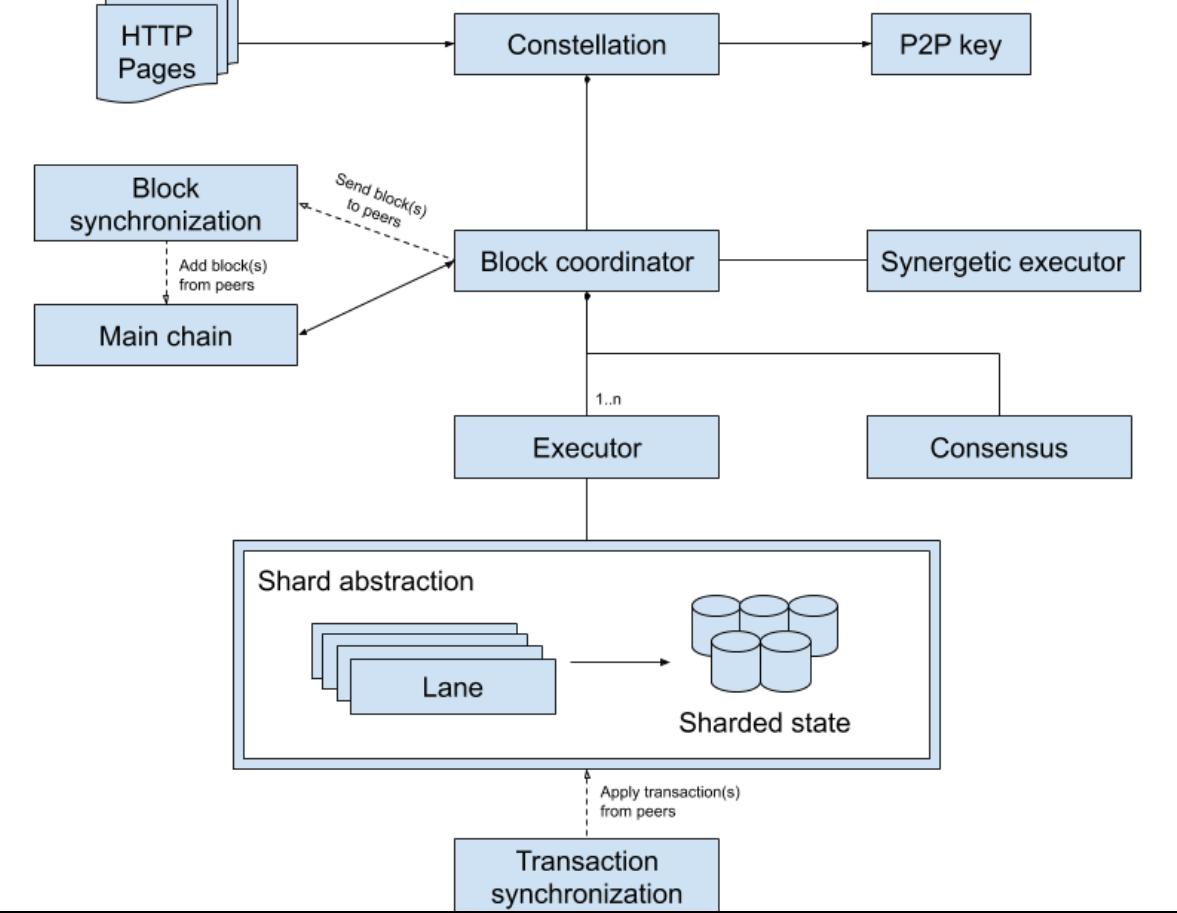

The Fetch.ai network has been the target of a DDoS attack, temporarily disrupting its services. This raises some security concerns about the project. Fetch is still under development, and it is not scalable. If the network becomes too congested, it could lead to slower transaction speeds and higher fees.
On the positive side, Fetch.ai is developing a real-world usage platform. The platform's technology, which includes machine learning, agents, and digital twins, has been used by some of the world's most reputed businesses, such as BMW, Ford, and Renault. These companies have used Fetch.ai to develop a decentralized platform for car sharing and ride-hailing, create a blockchain-based system for managing vehicle data, and other applications. Fetch.ai has partnered with Accenture, IBM, Datarella, and Bitget, further strengthening the platform and its growing ecosystem.
Fetch.ai is known for its ambitious goal to automate various tasks using AI and blockchain technology. Regarding sustainability and ESG considerations, Fetch.ai is paving the way for responsible tech innovation. It employs a consensus mechanism that is far more energy-efficient than traditional proofof-work systems, reducing its environmental impact. Socially, the platform focuses on creating decentralized and democratized access to information, aiming to mitigate societal inequities.
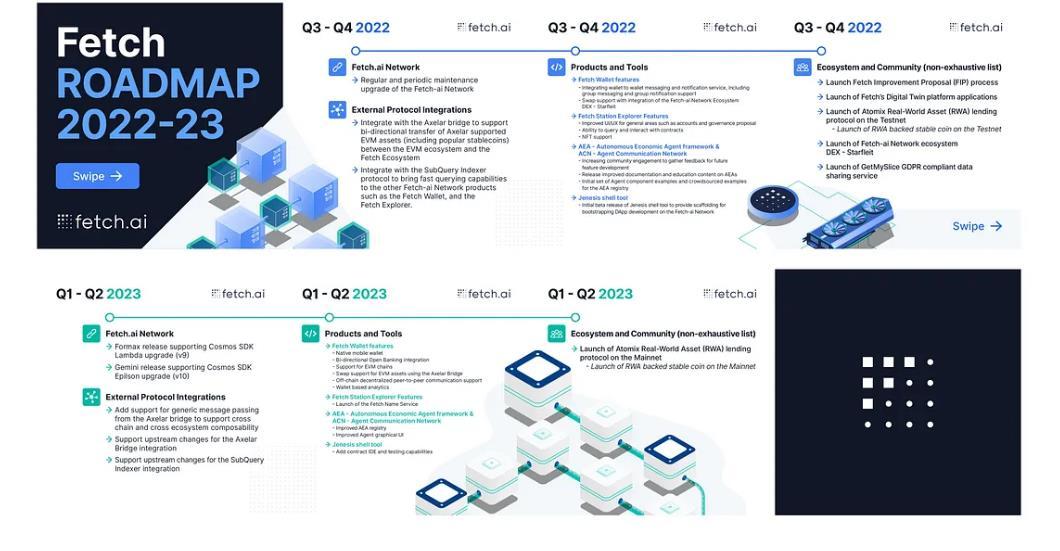
A virtual world where players can build, own, and monetize their gaming experiences, Sandbox exemplifies the transformative potential of blockchain in the gaming industry. As a prime example of the metaverse and "play-to-earn" theme, Sandbox offers intriguing insights into the future of digital economies.
The Sandbox is a decentralized, community-driven virtual world where users can create, own, and monetize their gaming experiences. The platform is built on the Polygon blockchain, a more scalable and efficient alternative to Ethereum. Users can create digital assets and experiences using The Sandbox's free software tools like VoxEdit and Game Maker. These assets can be used to build games, dioramas, art galleries, and other experiences. Users can also purchase Land in The Sandbox, which can be used to host their creations or rent out to other users.
Sandbox's native token is SAND Users can use the SAND token to buy land wearable items, build games, buy digital assets, buy game items such as weapons and characters, and buy buildings. Users can use the SAND token for staking and governance. Users can use Sand tokens for paying experience.
The Sandbox Metaverse is a decentralized virtual gaming platform that is community-driven. Users have the right to develop, operate, and propose modifications to the platform. The Sandbox provides creators with tools and resources to create and monetize their content, which can be rewarded through SAND tokens. The Sandbox also offers play-to-earn games, where users can earn SAND tokens by playing games, creating content, and participating in the Sandbox ecosystem. This feature makes the Sandbox platform more rewarding for users and incentivizes them to contribute to the community.
Sandbox is interoperable with other blockchain platforms where users can transfer digital assets from one platform to another. Users can also access the Sandbox platform on mobile devices. Sandbox offers several staking rewards systems to their users, such as the Land staking program, Sand token staking program, and Exclusive landowner staking program. The Land staking program involves users staking their Land to receive rewards through GEMs, Catalysts, and Sand tokens. The Sand token staking program involves users staking their sand tokens into a staking pool to earn rewards for additional sand. The exclusive landowners' staking program involves users staking their exclusive Land to receive extra rewards.
Sandbox provides its users with a marketplace where creators and users create, buy, and sell digital assets on this marketplace. The marketplace will allow the trading of interoperable tokenized assets between different games and platforms. Only approved Voxel artists will be able to upload NFTs to the market.
Sandbox is a decentralized gaming virtual world where users can create, own, and monetize their gaming experiences. Sandbox was built on an Ethereum blockchain but migrated to the Polygon blockchain in November 2022. It is a play-to-earn type of gaming platform. Still, users can also create content, monetize their experiences, and give their Land on the lease, and users can own digital assets like Land, property, wearable items, etc., in the Sandbox.
Sandbox's operating model combines blockchain, NFTs, and gaming technology. Sandbox uses the Ethereum blockchain to store platform data, including transactions, ownership of land, property, and wearables items. Sandbox uses various ERC token standards for NFTs, such as ERC-721 for lands that are non-fungible and ERC-1155 for entities (peoples, animals), equipment (swords, shields, and helmets), and wearables (cosmetic items changing an avatar’s), etc.
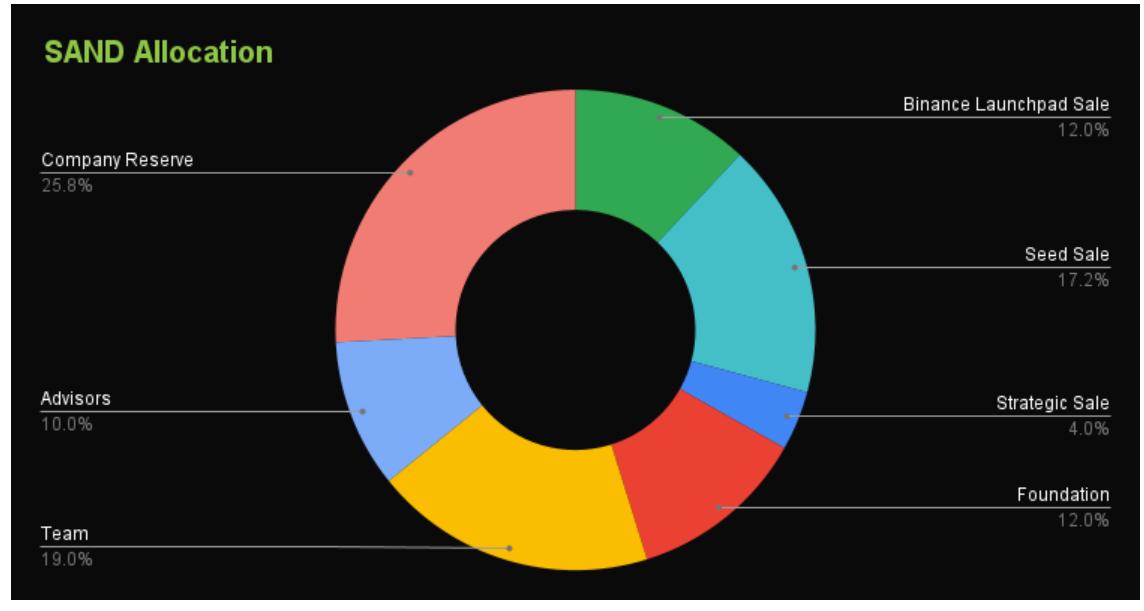
Sandbox utilizes gaming technology using Vox Edit and Game Maker software, where users can create virtual worlds, interact, own, and monetize their gaming experiences in a virtual world. Vox Edit is a 3D modeling tool that allows users to create their assets. Game Maker is a game creation tool that allows users to create their games within the sandbox metaverse.
The Sandbox platform supports ERC-20 token standards such as GEMs, Catalyst, and Sand Tokens. These tokens are awarded to players playing games on the Sandbox platform GEMs define attributes that are destroyed upon use, Catalysts define an asset’s tier and scarcity, and SAND tokens represent rewards.
Launch the Alpha Season 2 – The Alpha Season 2 will feature new features such as multiplayer gameplay, land staking, wearables, etc. It will also include new things like a battle royale mode and a role-playing game.
Launch the Beta- This stage will be a public testnet, allowing users to try out the latest features and provide feedback. The Beta will also be used to stress test the network and ensure it is ready for the mainnet launch. It is scheduled to be released in Q3 2023.
Launch the Mainnet: This will be the official launch of Alpha Season 2, where users can create, own, and monetize their experience. It is scheduled to be released in Q4 2023.
Expand the NFT ecosystem – By adding new types of NFTs, such as wearables and consumables. Partner with major brands – To grow their ecosystem by partnering with major brands to bring their IPs to the metaverse.
Develop new games and experience – This will help Sandbox keep users engaged and returning for more.
The Sandbox, a decentralized virtual gaming world, has captured attention for its user-generated content and economic opportunities. The Sandbox proactively addresses concerns regarding sustainability and ESG considerations. On the environmental front, the platform is exploring more energy-efficient blockchain protocols to minimize its carbon footprint. Socially, it aims to foster an inclusive and diverse community, offering educational resources to promote ethical interactions and responsible digital citizenship. In terms of governance, The Sandbox is committed to transparency, ensuring that decision-making processes are open and auditable.
As the native cryptocurrency of the OKEx trading platform, OKB has carved out a significant niche in the crypto ecosystem. With OKEx's focus on fostering a global blockchain community and facilitating digital asset trading, OKB holds a unique position within the evolving panorama of Web3 projects.
OKB is the native token of the OKX exchange, where users can use OKB tokens to pay trading fees, participate in token sales, vote on governance proposals, and earn staking rewards. OKB is also the native token of the OKB Chain. This token can be used on OKB Chain to pay transaction fees, vote on governance proposals, and for staking. OKB Chain has not been released yet. According to their roadmap, they will launch their mainnet in the fourth quarter of 2023. OKB token is a native of the OKX exchange, which is the second most popular exchange by trading volume globally.
OKB tokens enable users to pay fees on the OKX exchange, participate in governance for staking purposes, and access exclusive features.
OKB token is a native token of OKX exchange used to pay fees, use for Staking purposes, get discounted trading features, participate in governance, and access exclusive features on the OKX exchange platform. The OK Blockchain Foundation has been working on developing its blockchains, One is layer1, and the second is layer2 to scale layer1 blockchains using zkEVM layer2 network. We may see the more excellent utility of the OKB token when both blockchains launch their mainnets.
Most of the time, OKB tokens are used by users to get discounted trading fees on OKX exchange. This feature makes OKB tokens more attractive for traders to hold and earn discounted trading fees. The discount is based on the number of OKB tokens a user has.
OKB, the utility token of the OKEx exchange, plays a vital role in a vast financial ecosystem. Concerning sustainability and ESG considerations, OKB aims to balance performance with responsibility. From an environmental standpoint, OKEx is exploring energy-efficient mechanisms to reduce the overall carbon footprint associated with OKB transactions. Socially, OKEx focuses on financial inclusion, education, and ethical trading practices to foster a responsible and diverse community. Governance is maintained with high transparency and regulatory compliance, ensuring ethical conduct and stakeholder trust.

